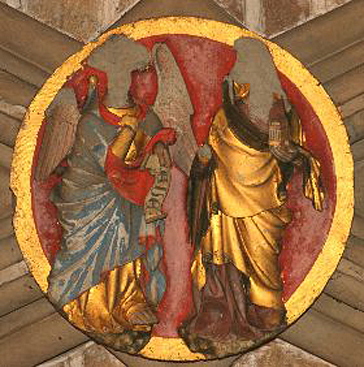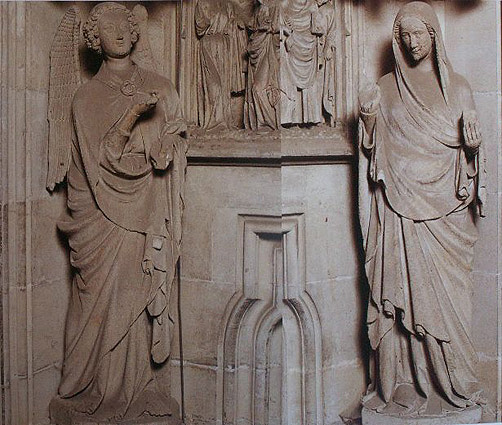The piece of the month of January 2007
THE CORE TOPIC OF THE ANNUNCIATION OF THE REFECTORY: A CLUE TO DATE THE SCULPTURE OF THE CLOISTER OF PAMPLONA
Santiaga Hidalgo Sánchez
Chair de Patrimonio y Arte Navarro
The refectory is undoubtedly the most spectacular medieval dependency of those preserved in the cloistered complex of the cathedral of Pamplona, which is one of the most complete in Europe. Contributing to its magnificence are the keystones, which present a heraldic program related to the kingdom of Navarre. In the words of the authors of Heraldic Emblems in Navarrese Medieval Art: "The refectory of the Pamplona church, with its thirty-one keystones with heraldic decoration, is the oldest of the great monumental armorials of Spain and one of the most interesting sets of medieval heraldry in our peninsula". In addition to these thirty-one heraldic keystones, there are another ten with vegetal motifs and four with religious themes.
In spite of the profound study that has been carried out on the heraldic keystones, and to which probably little more needs to be added, there is one piece of information regarding one of the religious-themed keystones that until now had gone unnoticed by the authors who had dealt with the refectory, and which leads us to propose the need for a revision of the chronology attributed to a large part of the sculpture of the cloister.
We are talking about the similarities between this core topic, that of the Annunciation, and the statues representing the same topic on the jambs of the Preciosa door.

core topic of the Annunciation in the refectory of the cathedral of Pamplona

Precious Door Jambs, Angel and Virgin of the Annunciation
If we compare both pieces, it is obvious that the postures and folds of the figures are identical. The mantles of the Virgin and the Angel have the same shapes both in the figures of the core topic and in the sculptures of the jambs. In both cases the folds are plastic, tubular and with helicoidal finials, and even the Angel's wings are also the same in their formulation. There are only two differences. On the one hand, the absence in the brooch of the Angel of the core topic of the decorative motif that does appear in that of the Preciosa. But this can be attributed to the fact that, given the height of the core topic, it would be almost impossible to see such a small detail, and therefore it was not "worth it" to sculpt it. On the other hand, the few remains of hair that are preserved in the figure of the Virgin of the core topic are the same as those of the rest of the keystones of the refectory -combed with helicoidal and symmetrical loops- and have nothing to do with those of the Virgin of the Preciosa.
In spite of this, the similarities are such that it is necessary to admit that one of the two elements has copied the other, or one can even think of the same sculptor. The problem in accepting this theory is that the refectory has a certain date of completion, 1335, according to the registration of the mural painting that was found on its headwall. The decoration of the vault must have been done between 1328, given the presence of the coat of arms of the house of Evreux, enthroned in Navarre from that date, and 1335. However, the sculpture of the Preciosa door, for which we do not have any document or precise data as in the case of the refectory, has been dated by the last author who has written about it -Martínez Álava- around 1350-1360, during the last years of Barbazán's episcopate or after his death. Thus, if we accept this chronology proposal for the Preciosa door, at least 15 years would separate the realization of both works.
In the case that one work is model for the other, it seems more likely that the original work is that of the jambs, because the vault core topic is a minor work, located in a place of difficult access. It could be argued that perhaps the statues of the jambs were made years before their placement, so they could have been made at the same time, or serve as model for the core topic of the refectory. However, it seems unlikely, since these statues share formal characteristics with the sculptures of the tympanum, and were therefore made at the same time.
In view of the above, we believe that the similarities between the core topic of the Annunciation and the statues of the jambs of the Preciosa give us a clue to opt for an earlier chronology of the latter. Thus, our opinion coincides with that of authors such as Gardelles, who dated the Preciosa door, due to its similarities with Bordeaux, around 1330, or Uranga and Íñiguez, who considered it contemporary to the Amparo door, which they also dated around 1330.
bibliography:
FERNÁNDEZ-LADREDA , C.; LORDA IÑARRA, J., "La catedral gótica. Architecture" in La catedral de Pamplona, Pamplona, Caja de Ahorros de Navarra, 1994, pp. 164-273.
GARDELLES, J., Aquitaine gothique, Paris, Picard, 1992.
MARTÍNEZ ÁLAVA, C., "La catedral gótica. Sculpture" in La catedral de Pamplona, Pamplona, Caja de Ahorros de Navarra, 1994, pp. 274-354.
MARTÍNEZ DE AGUIRRE, J.; MENÉNDEZ PIDAL, F., Emblemas heráldicos en el arte medieval navarro, Pamplona, Gobierno de Navarra, department de Education, Cultura, Deporte y Juventud, 1996.
MARTÍNEZ DE AGUIRRE, J.; MENÉNDEZ PIDAL, F., "Precisiones cronológicas y heráldicas sobre el mural del refectorio de la catedral de Pamplona" in Príncipe de Viana, Nº 207, 1996, pp. 5-18.
URANGA, J. E.; ÍÑIGUEZ, F., Arte Medieval Navarro, volume 5, Pamplona, Aranzadi, 1973.
